The Life and Death of Jamoytius kerwoodi White; A Silurian Jawless Nektonic Herbivore?
Abstract
1. Introduction
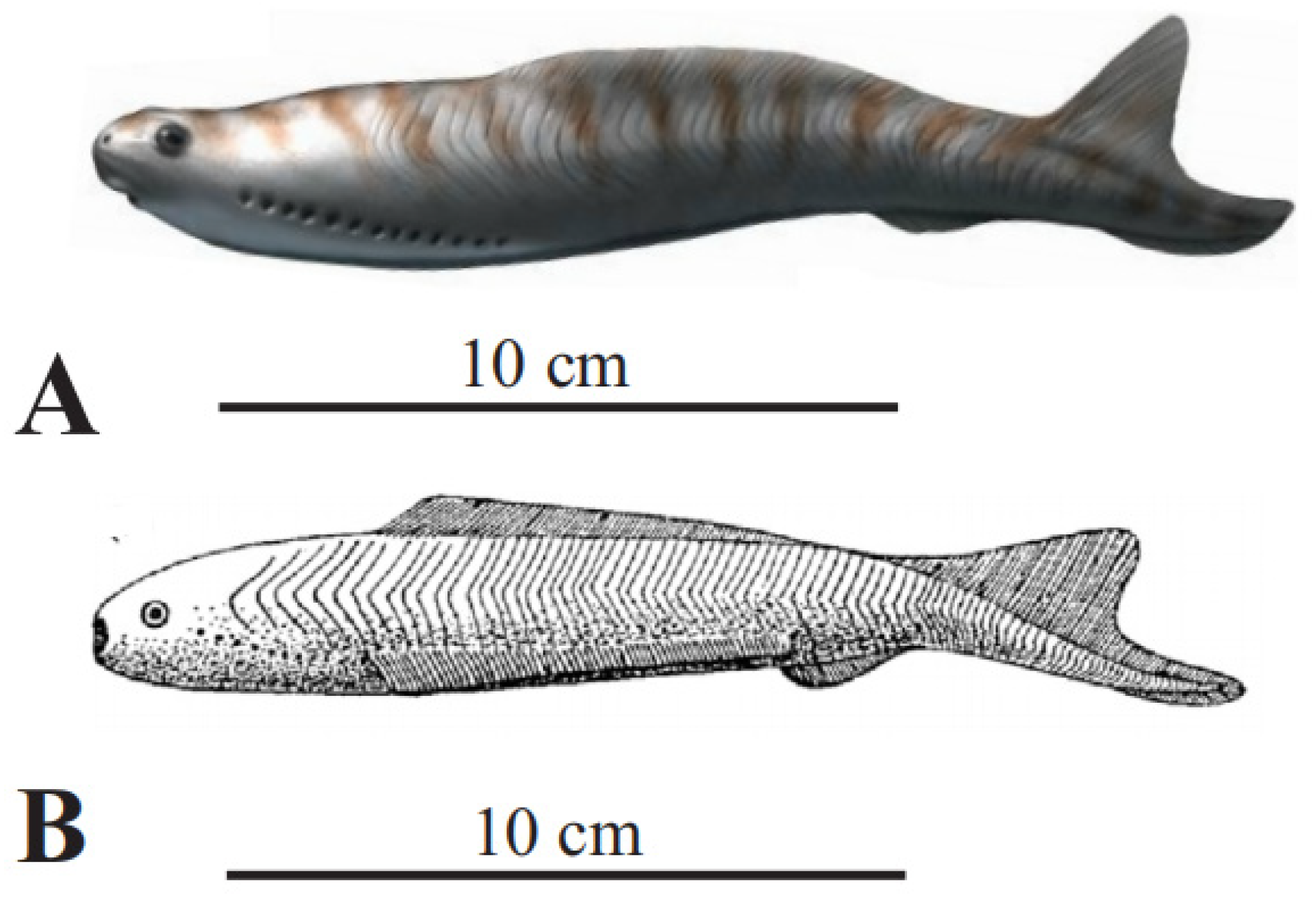
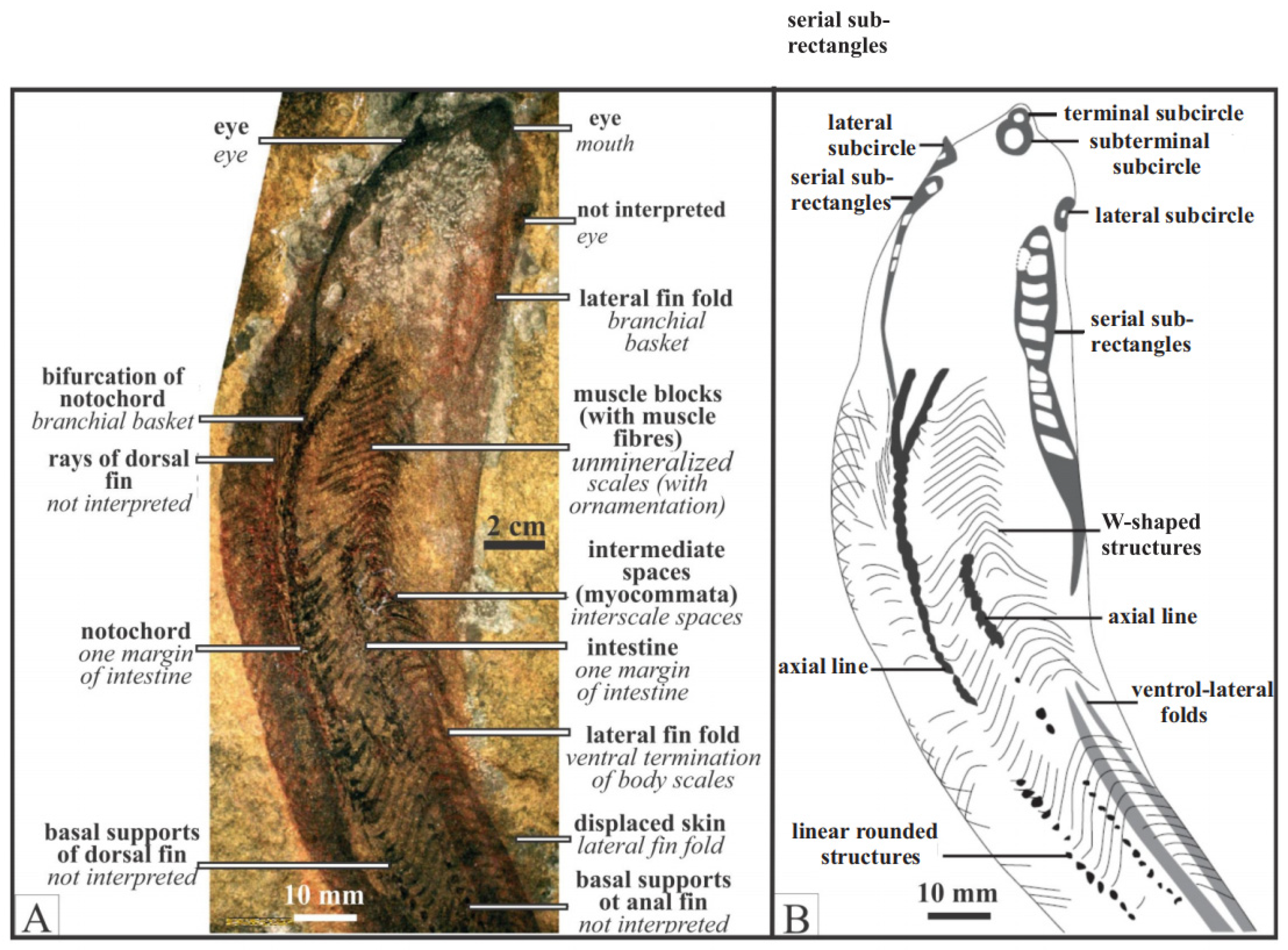

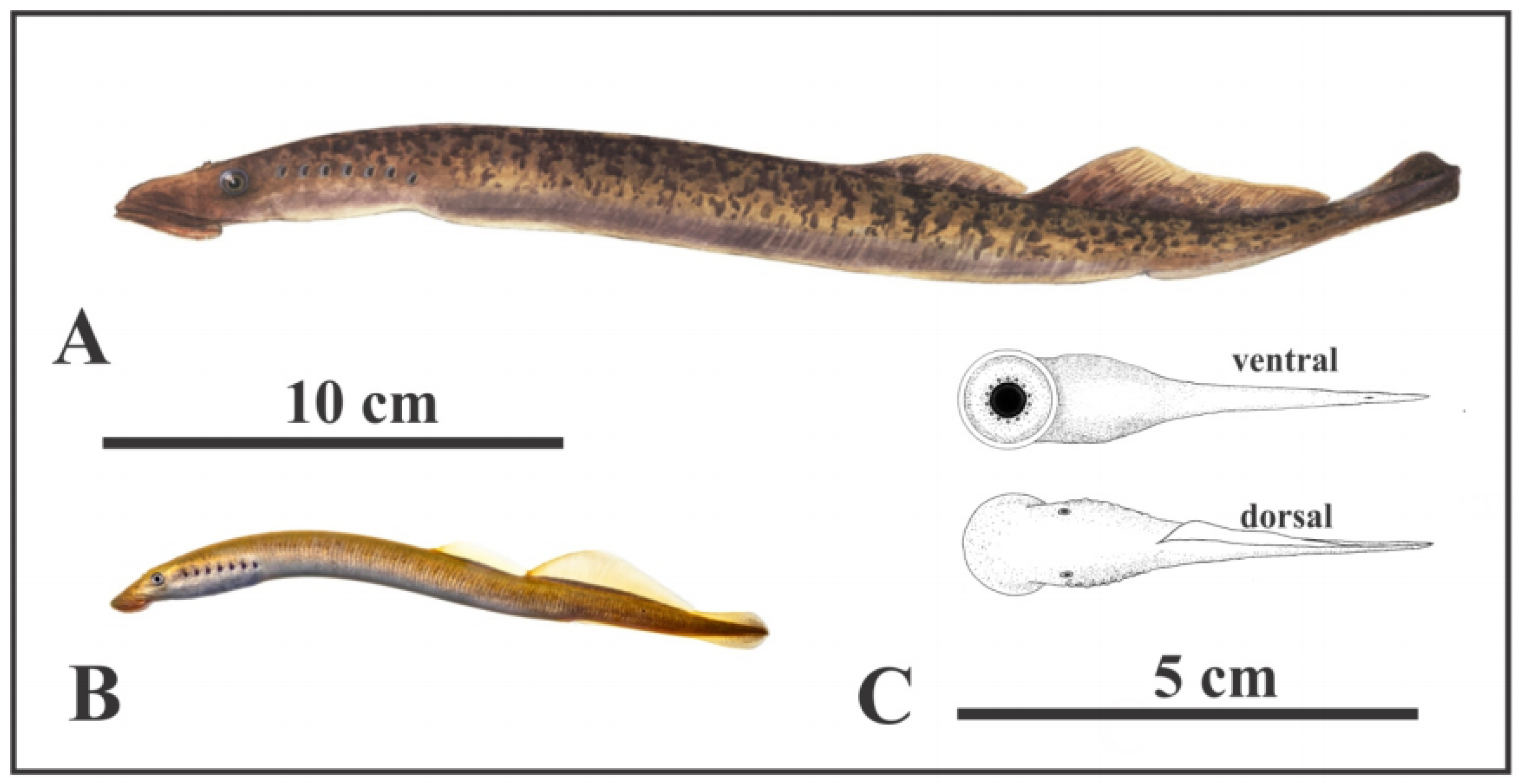
2. Anatomy
3. Mode of Life of Jamoytius
4. Paleoenvironments
5. Palaeoecology
6. Discussion
7. Conclusions
Funding
Data Availability Statement
Acknowledgments
Conflicts of Interest
References
- White, E.I. Jamoytius kerwoodi, a new chordate from the Silurian of Lanarkshire. Geol. Mag. 1946, 83, 89–97. [Google Scholar] [CrossRef]
- Ritchie, A. New evidence on Jamoytius kerwoodi White, an important ostracoderm from the Silurian of Lanarkshire, Scotland. Palaeontology 1968, 11, 21–39. [Google Scholar]
- Chevrinais, M.; Johanson, Z.; Trinajstic, K.; Long, J.; Morel, C.; Renaud, C.; Cloutier, R. Evolution of vertebrate postcranial complexity: Axial skeleton regionalization and paired appendages in a Devonian jawless fish. Palaeontology 2018, 61, 949–961. [Google Scholar] [CrossRef]
- Janvier, P. Early Vertebrates. Oxford Monographs on Geology and Geophysics 33; Clarendon Press: Oxford, UK, 1996; 393p. [Google Scholar] [CrossRef]
- Janvier, P. Early Jawless Vertebrates and Cyclostome Origins. Zool. Sci. 2008, 25, 1045–1056. [Google Scholar] [CrossRef]
- Keating, J.N.; Donaghue, P.C.J. Histology and affinity of anaspids, and the early evolution of the vertebrate dermal skeleton. Proc. R. Soc. 2016, B283, 20152917. [Google Scholar] [CrossRef]
- Miyashita, T.; Coates, M.; Farrar, R.; Larson, P.; Manning, P.; Wogelius, R.; Edwards, N.; Anné, J.; Bergmann, U.; Palmer, A.; et al. Hagfish from the Cretaceous Tethys Sea and a reconciliation of the morphological-molecular conflict in early vertebrate phylogeny. Proc. Natl. Acad. Sci. USA 2019, 116, e2146–e2151. [Google Scholar] [CrossRef]
- Miyashita, T.; Gess, R.W.; Tietjen, K.; Coates, M.I. Non-ammocoete larvae of Palaeozoic stem lampreys. Nature 2021, 591, 408–412. [Google Scholar] [CrossRef]
- Donoghue, P.C.J.; Purnell, M.A. Distinguishing heat from light in debate over controversial fossils. BioEssays 2009, 31, 178–189. [Google Scholar] [CrossRef]
- Lingham-Soliar, T. The Vertebrate Integument: Origin and Evolution, Volume 1; Springer: Berlin/Heidelberg, Germany, 2014; 268p. [Google Scholar]
- Reeves, J.C.; Sansom, R.S. Multivariate mapping of ontogeny, taphonomy and phylogeny to reconstruct problematic fossil taxa. Proc. R. Soc. B 2023, 290, 20230333. [Google Scholar] [CrossRef]
- Forey, P.L. Yet more reflections on agnatha-gnathostome relationships. J. Vertebr. Paleontol. 1984, 4, 330–343. [Google Scholar] [CrossRef]
- Forey, P.L. Agnathans recent and fossil, and the origin of jawed vertebrates. Rev. Fish Biol. Fish. 1995, 5, 267–303. [Google Scholar] [CrossRef]
- Forey, P.L.; Janvier, P. Agnathans and the origin of jawed vertebrates. Nature 1993, 361, 129–134. [Google Scholar] [CrossRef]
- Janvier, P. The phylogeny of the Craniata, with reference to the significance of fossil ‘agnathans’. J. Vertebr. Paleontol. 1981, 1, 121–159. [Google Scholar] [CrossRef]
- Kuraku, S.; Kuratani, S. Time Scale for Cyclostome Evolution Inferred with a Phylogenetic Diagnosis of Hagfish and Lamprey cDNA Sequences. Zool. Sci. 2006, 23, 1053–1064. [Google Scholar] [CrossRef]
- Reeves, J.C.; Wogelius, R.; Keating, J.; Sansom, R.S. Lasanius, an exceptionally preserved Silurian jawless fish from Scotland. Palaeontology 2023, 66, e12643. [Google Scholar] [CrossRef]
- Ritchie, A. A new interpretation of Jamoytius kerwoodi White. Nature 1960, 188, 647–649. [Google Scholar] [CrossRef]
- Shu, D.; Luo, H.-L.; Conway-Morris, S.; Zhang, X.; Hu, S.; Han, J.; Zhu, M.; Li, Y.; Chen, L.-Z. A Lower Cambrian vertebrate from South China. Nature 1999, 402, 42–46. [Google Scholar] [CrossRef]
- Turner, S. Early vertebrates: Analysis from microfossil evidence. Recent Adv. Orig. Early Radiat. Vertebr. 2004, 65, 67–94. [Google Scholar]
- Donoghue, P.C.J.; Smith, M.P.; Sansom, I.J. The origin and early evolution of chordates: Molecular clocks and the fossil record. In Telling the Evolutionary Time: Molecular Clocks and the Fossil Record; Donoghue, P.C.J., Smith, M.P., Eds.; CRC Press: London, UK, 2003; pp. 190–223. [Google Scholar]
- Gess, R.W.; Coates, M.I.; Rubidge, B.S. A lamprey from the Devonian period of South Africa. Nature 2006, 443, 981–984. [Google Scholar] [CrossRef]
- Donoghue, P.C.J.; Keating, J.N. Early vertebrate evolution. Palaeontology 2014, 57, 879–893. [Google Scholar] [CrossRef]
- Janvier, P.; Arsenault, M. The anatomy of Euphanerops longaevus Woodward, 1900, an anaspid-like jawless vertebrate from the Upper Devonian of Miguasha, Quebec, Canada. Godiversitas 2007, 29, 143–216. [Google Scholar]
- Ritchie, A. Conflicting interpretations of the Silurian agnathan, Jamoytius. Scott. J. Geol. 1984, 20, 249–256. [Google Scholar] [CrossRef]
- Potter, I.C.; Gill, H.S.; Renaud, C.B.; Haoucher, D. The Taxonomy, Phylogeny, and Distribution of Lampreys. In Lampreys: Biology, Conservation and Control; Docker, M.F., Ed.; Springer: Dordrecht, The Netherlands, 2015; pp. 35–73. [Google Scholar] [CrossRef]
- Docker, M.F. A review of the evolution of nonparasitism in lampreys an update of the paired species concept. In Biology, Management, and Conservation of Lampreys in North America; Brown, L., Chase, S., Mesa, M., Beamish, R., Moyle, P.B., Eds.; American Fisheries Society: Bethesda, MD, USA, 2009; pp. 71–114. [Google Scholar]
- Evans, T.M.; Limburg, K.E. Parasitism offers large rewards but carries high risks: Predicting parasitic strategies under different life history conditions in lampreys. J. Evol. Biol. 2019, 32, 794–805. [Google Scholar] [CrossRef] [PubMed]
- Dawson, H.A.; Quintella, B.R.; Almeida, P.R.; Treble, A.J.; Jolley, J.C. The ecology of larval and metamorphosing lampreys. In Lampreys: Biology, Conservation and Control; Docker, M.F., Ed.; Springer: Berlin/Heidelberg, Germany, 2015; Volume 1, pp. 75–138. [Google Scholar]
- Ritchie, A. Palaeontological Studies on Scottish Silurian Fish Beds. Ph.D. Thesis, University of Edinburgh, Edinburgh, UK, 1963; 170p. [Google Scholar]
- Sansom, R.S.; Freedman, K.; Gabbott, S.E.; Aldridge, R.J.; Purnell, M.A. Taphonomy and affinity of an enigmatic Silurian vertebrate, Jamoytius kerwoodi White. Palaeontology 2010, 53, 1393–1409. [Google Scholar] [CrossRef]
- Brownstein, C.D.; Near, T.J. Phylogenetics and the Cenozoic Radiation of lampreys. Curr. Biol. 2023, 33, 397–404. [Google Scholar] [CrossRef]
- Wu, F.; Janvier, P.; Zhang, C. The rise of predation in Jurassic lampreys. Nat. Commun. 2023, 14, 6652. [Google Scholar] [CrossRef] [PubMed]
- Mallatt, J. Vertebrate origins are informed by larval lampreys (ammocoetes): A response to Miyashita et al., 2021. Zool. J. Linn. Soc. 2023, 197, 287–321. [Google Scholar] [CrossRef]
- Blom, H.; Märss, T. The interrelationships and evolutionary history of anaspid fishes. In Morphology, Phylogeny, and Paleobiogeography of Fossil Fishes; Elliott, D.K., Maisey, J.G., Yu, X., Miao, D., Eds.; Verlag Dr. F. Pfeil, Munich: Munich, Germany, 2010; pp. 45–58. [Google Scholar]
- Dineley, D. Silurian fossils fish sites of Scotland. In Fossil Fishes of Great Britain; Chapter 2; Geological Conservation Review Series; Dineley, D., Metcalf, S., Eds.; Joint Nature Conservation Committee: Peterborough, UK, 1999; Volume 16, pp. 33–62. [Google Scholar]
- Lovelock, C.E. Sedimentary Environments and Biofacies of the Silurian Inlier at Lesmahagow Midland Valley of Scotland. Ph.D. Thesis, University of Edinburgh, Edinburgh, UK, 1998; 448p. [Google Scholar]
- Tarlo, L.B.H. Agnatha. In The Fossil Record; Harland, W.B., Ed.; London Geological Society: London, UK, 1967; pp. 629–636. [Google Scholar]
- van der Brugghen, G. Ciderius cooperi gen. nov., sp. nov., the earliest known euphaneropid from the Lower Silurian of Scotland. Neth. J. Geosci. 2015, 94, 279–288. [Google Scholar] [CrossRef]
- Stensiö, E.A. Les cyclostomes fossiles ou ostracodermes. In Traite de Zoologie 13; Grasse, P.-P., Ed.; Masson: Paris, France, 1958; pp. 173–425. [Google Scholar]
- Moyer, A.E.; Zheng, W.; Schweitzer, M.H. Keratin durability has implications for the fossil record: Results from a 10-year feather degradation experiment. PLoS ONE 2016, 11, e0157699. [Google Scholar] [CrossRef]
- Schweitzer, M.H.; Zheng, W.; Moyer, A.E.; Sjövall, P.; Lindgren, J. Preservation potential of keratin in deep time. PLoS ONE 2018, 13, e0206569. [Google Scholar] [CrossRef]
- Richardson, M.K.; Admiraal, J.; Wright, G.M. Developmental anatomy of lampreys. Biol. Rev. 2010, 85, 1–206. [Google Scholar] [CrossRef] [PubMed]
- Blom, H. New Birkeniid anaspid from the Lower Devonian of Scotland and its phylogenetic implications. Palaeontology 2012, 55, 641–652. [Google Scholar] [CrossRef]
- Cochran, P.A. Observations on giant American Brook Lamprey (Lampetra appendix). J. Freshw. Ecol. 2008, 23, 161–164. [Google Scholar] [CrossRef]
- Fuller, P.; Neilson, M. Lethenteron appendix; USGS Nonindigenous Aquatic Species Database: Gainesville, FL, USA, 2015. Available online: http://nas.er.usgs.gov/queries/FactSheet.aspx?speciesID=835 (accessed on 5 December 2023).
- Oleh, M. Laboratory Manual on General and Special Ichthyology. World News Nat. Sci. 2018, 18, 1–51. [Google Scholar]
- Clarkson, E.N.K.; Harper, D.T. Silurian of the Midland Valley of Scotland and Ireland. Geol. Today 2016, 32, 195–200. [Google Scholar] [CrossRef]
- Jennings, J.S. The geology of the Eastern Part of the Lesmahagow Inlier. Ph.D. Thesis, The University of Edinburgh, Edinburgh, UK, 1961; 306p. [Google Scholar]
- Harms, J.C.; Southard, J.B.; Spearing, D.R.; Walker, R.G. Depositional Environments as Interpreted from Primary Sedimentary Structures and Stratification Sequences; Society for Economic Petrology and Mineralogy: Tulsa, OK, USA, 1975; 161p. [Google Scholar] [CrossRef]
- Armitage, S.J.; Bristow, C.S.; Drake, N.A. West African monsoon dynamics inferred from abrupt fluctuations of Lake Mega-Chad. Proc. Natl. Acad. Sci. USA 2015, 112, 8543–8548. [Google Scholar] [CrossRef] [PubMed]
- González, C.; Dupont, L.M.; Behling, H.; Wefer, G. Neotropical vegetation response to rapid climate changes during the last glacial period: Palynological evidence from the Cariaco Basin. Quat. Res. 2008, 69, 217–230. [Google Scholar] [CrossRef]
- Zolitschka, B.; Francus, P.; Antti, E.K.O.; Schimmelmann, A. Varves in lake sediments a review. Quat. Sci. Rev. 2015, 117, 1–41. [Google Scholar] [CrossRef]
- Athearn, W.D. Sediment Cores from the Cariaco Trench, Venezuela; Unpublished Technical Report; Woods Hole Oceanographic Institution: Woods Hole, MA, USA, 1965; pp. 65–73. 20p. [Google Scholar]
- Hughen, K.A.; Overpeck, J.T.; Peterson, L.C.; Anderson, R.F. The nature of varved sedimentation in the Cariaco Basin, Venezuela, and its paleoclimatic significance. Geol. Soc. Spec. Publ. 1996, 116, 171–183. [Google Scholar] [CrossRef]
- Muller-Karger, F.E.; Varela, R.; Thunell, R.; Scranton, M.; Bohrer, R.; Taylor, G.; Capelo, J.; Astor, Y.; Tappa, E.; Ho, T.Y.; et al. Annual cycle of primary production in the Cariaco Basin: Response to upwelling and implications for vertical export. J. Geophys. Res. 2001, 106, 4527–4542. [Google Scholar] [CrossRef]
- Dewey, J.F.; Strachan, R.A. Changing Silurian–Devonian relative plate motion in the Caledonides: Sinistral transpression to sinistral transtension. J. Geol. Soc. 2003, 160, 219–229. [Google Scholar] [CrossRef]
- James, K. The Venezuelan Hydrocarbon Habitat. Geol. Soc. Lond. Spec. Publ. 1990, 50, 9–35. [Google Scholar] [CrossRef]
- Peach, B.N.; Horne, J. The Silurian Rocks of Britain; Vol.1 Scotland. (with Petrological Chapters and Notes by J.J.H. Teall); Memoirs of the Geological Survey of the United Kingdom; HMSO: Glasgow, UK, 1899; 749p.
- Walton, E.K.; Oliver, G.J.H. Lower Palaeozoic stratigraphy. In Geology of Scotland, 3rd ed.; Craig, G.Y., Ed.; Scottish Academic Press: Edinburgh, UK, 1991; pp. 161–193. [Google Scholar]
- Anderson, L.I. A new specimen of the Silurian synziphosurine arthropod Cyamocephalus. Proc. Geol. Assoc. 1999, 110, 211–216. [Google Scholar] [CrossRef]
- Hunter, J.R.S. Notes on a new fossil scorpion (Palaeophonus caledonicus) from the Upper Silurian Shales, Logan Water, Lesmahagow. Trans. Edinb. Geol. Soc. 1884, 5, 187–191. [Google Scholar] [CrossRef]
- van der Brugghen, G.; Schram, F.R.; Marthill, D.M. The Fossil Ainiktozoon is an arthropod. Nature 1997, 385, 589–591. [Google Scholar] [CrossRef][Green Version]
- Hessler, R.R.; Schram, F.R. Leptostraca as Living Fossils. In Living Fossils. Casebooks in Earth Sciences; Eldredge, N., Stanley, S.M., Eds.; Springer: New York, NY, USA, 1984; pp. 187–191. [Google Scholar] [CrossRef]
- Rolfe, W.D.I.; Beckett, E.C.M. Autecology of Silurian Xiphosurida, Scorpionida, Cirripedia, and Phyllocarida. Spec. Pap. Paleontol. 1984, 32, 27–37. [Google Scholar]
- Albertoni, E.F.; Palma-Silva, C.; Esteves, F.A. Overlap of dietary niche and electivity of three shrimp species (Crustacea, Decapoda) in a tropical coastal lagoon (Rio de Janeiro, Brazil). Rev. Bras. Zool. 2003, 20, 135–140. [Google Scholar] [CrossRef][Green Version]
- Rolfe, W.D.I. Phyllocarida and the origin of the Malacostraca. Geobios 1981, 14, 17–26. [Google Scholar] [CrossRef]
- Walker, I. Omnivory and resource-sharing in nutrient-deficient Rio Negro waters: Stabilization of biodiversity? Acta Amaz. 2009, 39, 617–626. [Google Scholar] [CrossRef][Green Version]
- Traquair, R.H. Report on fossil fishes collected by the Geological Survey of Scotland in the Silurian rocks of the south of Scotland. Trans. R. Soc. Edinb. 1899, 39, 827–864. [Google Scholar] [CrossRef]
- Turner, S. A new articulated thelodont (Agnatha) from the Early Devonian of Britain. Palaeontology 1982, 25, 879–889. [Google Scholar]
- Turner, S. Early Silurian to Early Devonian thelodont assemblages and their possible ecological significance. In Palaeocommunities: A Case Study from the Silurian and Lower Devonian-International Geological Correlation Programme 53, Project Ecostratigraphy, Final Report; Boucot, A.J., Lawson, J., Eds.; Cambridge University Press: Cambridge, UK, 1999; pp. 42–78. [Google Scholar]
- Gilmore, B. Scroll coprolites from the Silurian of Ireland and the feeding of early invertebrates. Palaeontology 1992, 35, 319–333. [Google Scholar]
- Scourfield, D.J. An anomalous fossil organism, possibly a new type of chordate, from the Upper Silurian of Lesmahagow, Lanarkshire—Ainiktozoon loganense, gen. et sp. nov. Proc. R. Soc. B 1937, 121, 533–547. [Google Scholar] [CrossRef]
- Haug, C.; Briggs, D.E.G.; Mikulic, D.G.; Kluessendorf, J.; Huag, J.T. The implications of a Silurian and other thylacocephalan crustaceans for the functional morphology and systematic affinities of the group. BMC Evol. Biol. 2014, 14, 159. [Google Scholar] [CrossRef] [PubMed]
- Störmer, L. Dictyocaris salter, a large crustacean from the Upper Silurian and Downtonian. Nor. Geol. Tidsskr. 1935, 15, 267–298. [Google Scholar]
- van der Brugghen, G. Dictyocaris, een enigmatisch fossiel uit het Silur. Grondboor Hamer 1995, 1, 18–22. [Google Scholar]
- Ritchie, A. Lanarkopterus dolichoschelus (Störmer) gen. nov., a mixopterid eurypterid from the Upper Silurian of the Lesmahagow and Hagshaw Hills inliers, Scotland. Scott. J. Geol. 1968, 4, 317–338. [Google Scholar] [CrossRef]
- Schmidt, M.; Melzer, R.R.; Plotnick, R.E.; Bicknell, R.D.C. Spines and baskets in apex predatory sea scorpions uncover unique feeding strategies using 3D-kinematics. Science 2022, 25, 103662. [Google Scholar] [CrossRef] [PubMed]
- Plotnick, R.E. Habitat of Llandoverian-Lochkovian eurypterids. In Paleocommunities—A Case Study from the Silurian and Lower Devonian; Boucot, A.J., Lawson, J.D., Eds.; Cambridge University Press: Cambridge, UK, 1999; pp. 106–136. [Google Scholar]
- Stanley, S.M. Functional morphology and evolution of byssally attached bivalves. J. Paleontol. 1972, 46, 165–212. [Google Scholar]
- Linsley, R.M. Some “laws” of gastropod shell form. Paleobiology 1977, 3, 196–206. [Google Scholar] [CrossRef]
- Denison, R.N. Feeding mechanisms of agnatha and early gnathostomes. Am. Zool. 1961, 1, 177–182. [Google Scholar] [CrossRef]
- Donoghue, P.C.J.; Smith, M.P. The anatomy of Turinia pagei (Powrie), and the phylogenetic status of the Thelodonti. Trans. R. Soc. Edinb. Earth Sci. 2001, 92, 15–37. [Google Scholar] [CrossRef]
- Donoghue, P.C.J.; Forey, P.L.; Aldridge, R.J. Conodont affinity and chordate phylogeny. Biol. Rev. 2000, 75, 191–251. [Google Scholar] [CrossRef] [PubMed]
- Ferrón, H.G.; Botella, H. Squamation and ecology of thelodonts. PLoS ONE 2017, 12, e0172781. [Google Scholar] [CrossRef]
- Mallatt, J. Feeding ecology of the earliest vertebrates. Zool. J. Linn. Soc. 1984, 82, 261–272. [Google Scholar] [CrossRef]
- Mallatt, J. Reconstructing the Life Cycle and the Feeding of Ancestral Vertebrates. In Evolutionary Biology of Primitive Fishes; NATO ASI Series; Foreman, R.E., Gorbman, A., Dodd, J.M., Olsson, R., Eds.; Springer: Boston, MA, USA, 1985; Volume 103, pp. 59–68. [Google Scholar] [CrossRef]
- Lammons, M.L. Mud and Mucus: Feeding Selectivity in a Suspension-Feeding Detritivorous Fish. Master’s Thesis, The College of William and Mary, Williamsburg, VA, USA, 2009; 101p. [Google Scholar]
- Parrington, F.R.; Westoll, T.S. On the nature of the Anaspida. In Studies on Fossil Vertebrates; Westoll, T.S., Ed.; Athlone Press: London, UK, 1958; pp. 108–128. [Google Scholar]
- Kermack, K.A. The functional significance of the hypocercal Tail in Pteraspis rostrata. J. Exp. Biol. 1943, 20, 23–27. [Google Scholar] [CrossRef]
- Fletcher, T.; Altringham, J.; Peakall, J.; Wignall, P.; Dorrell, R. Hydrodynamics of fossil fishes. Proc. R. Soc. 2014, B281, 20140703. [Google Scholar] [CrossRef]
- Strahan, A. The behaviour of Mixinoids. Acta Zool. Stockh. 1963, 44, 73–102. [Google Scholar] [CrossRef]
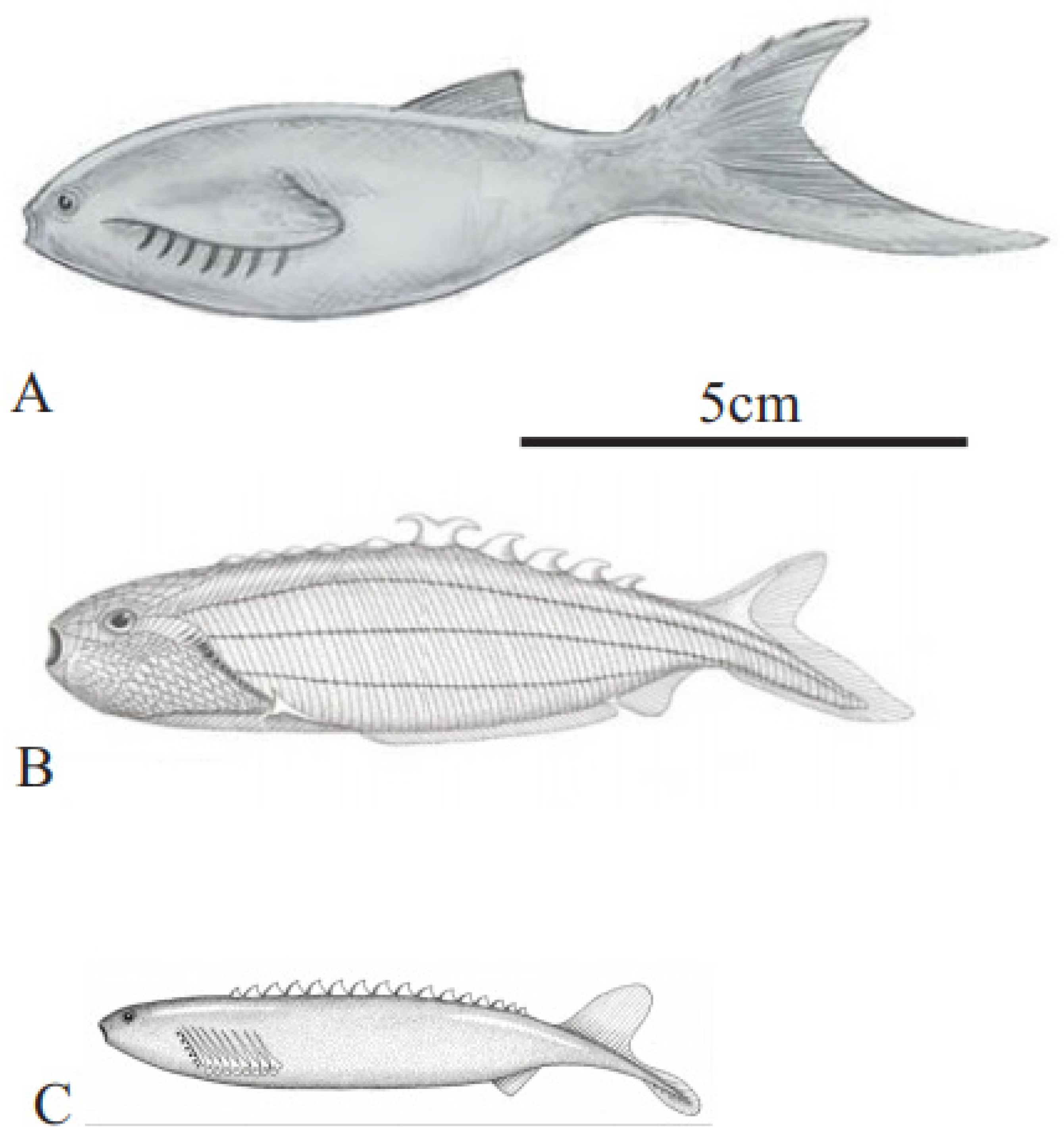
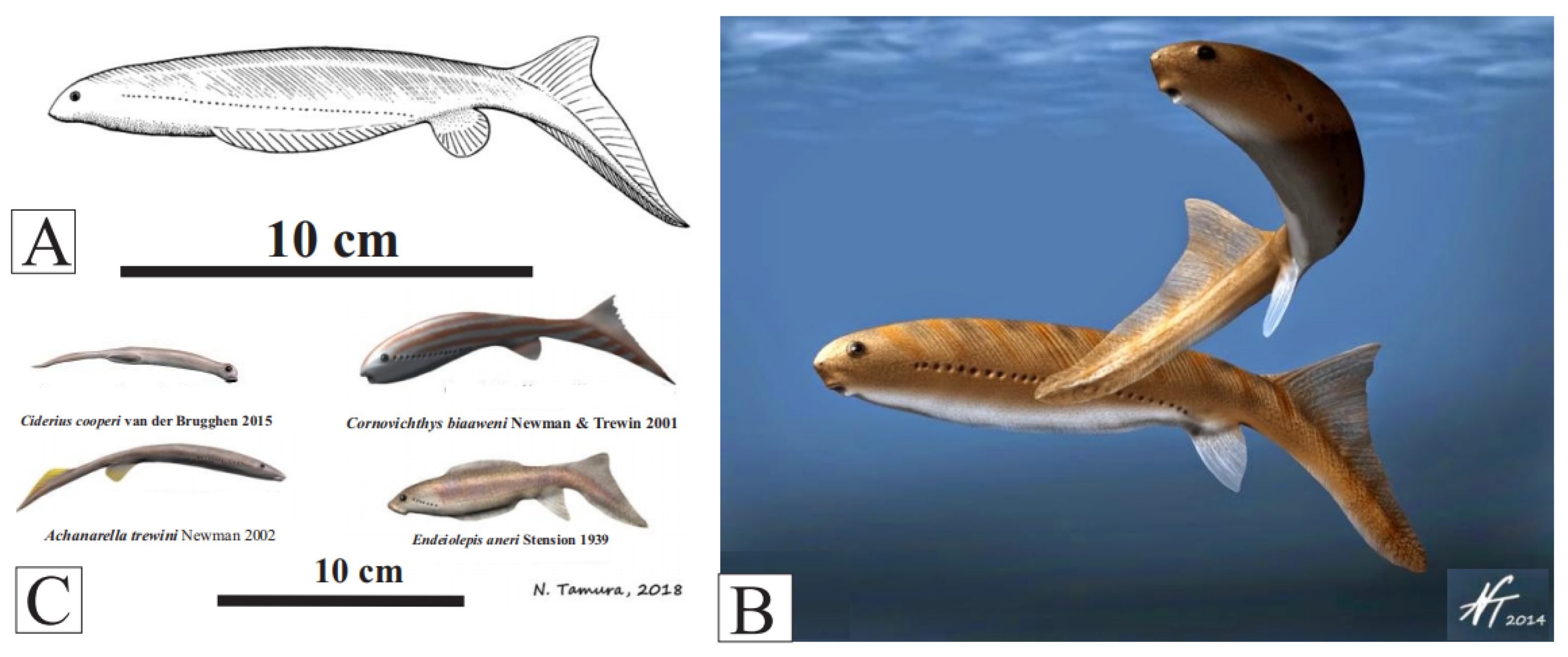
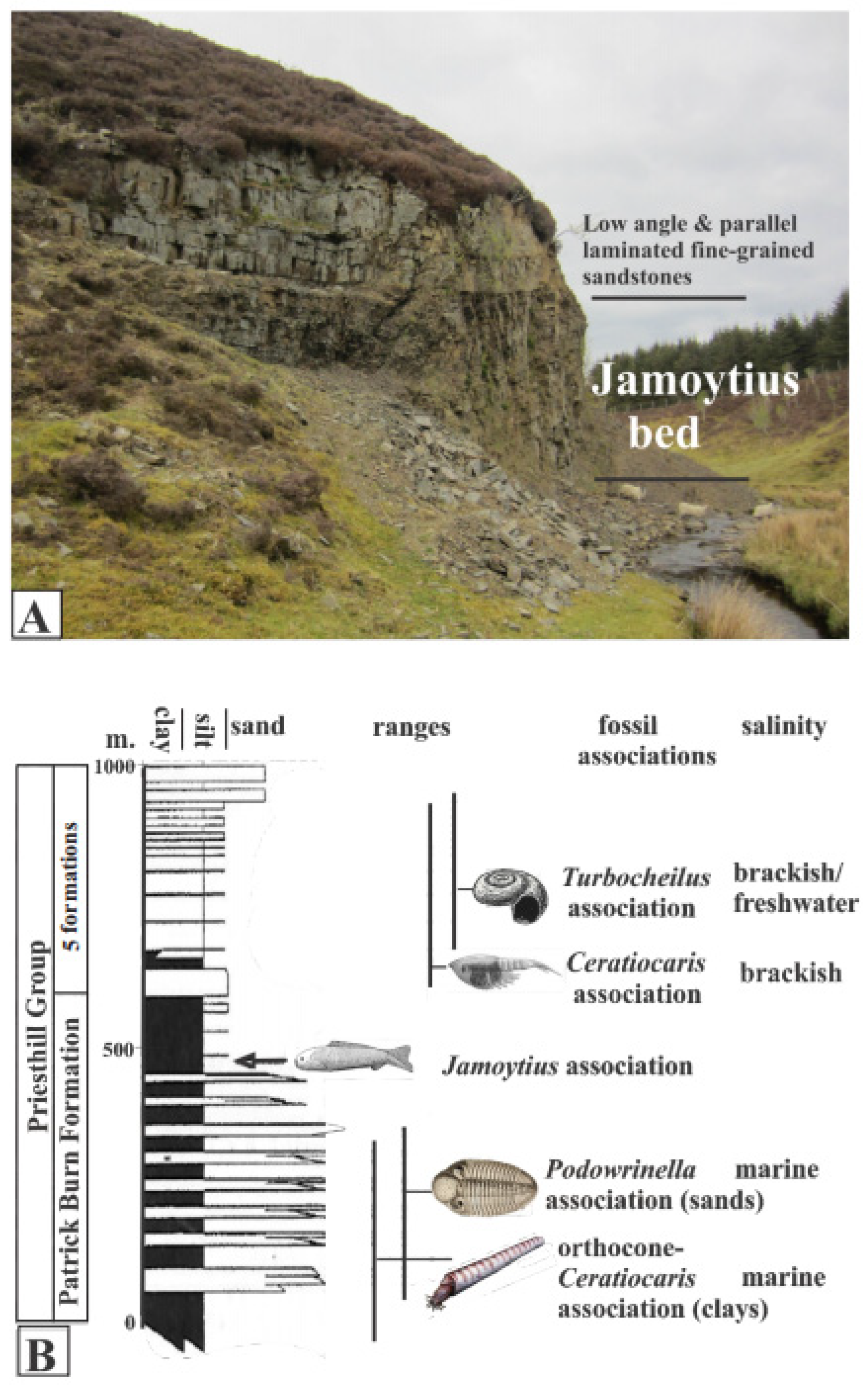

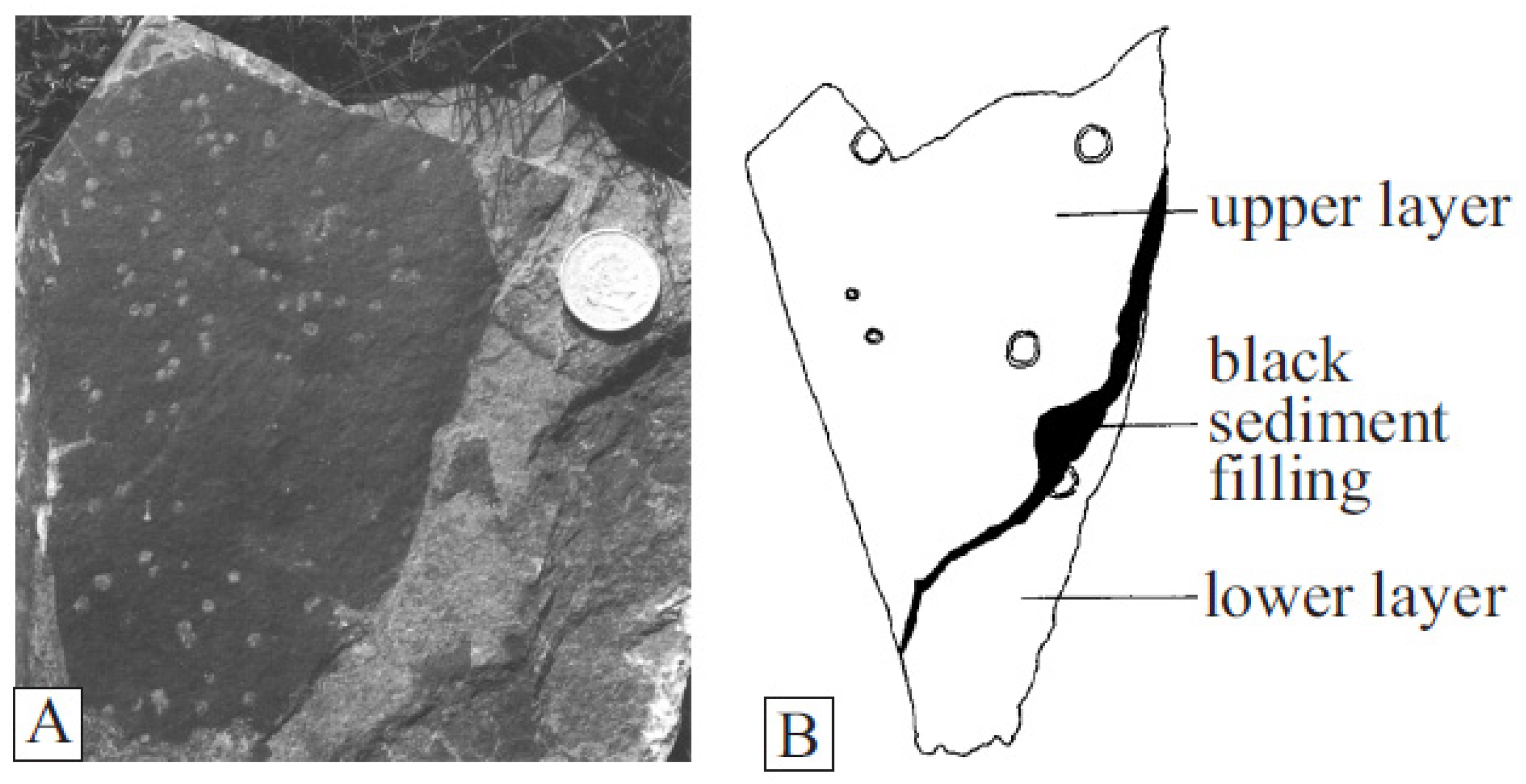
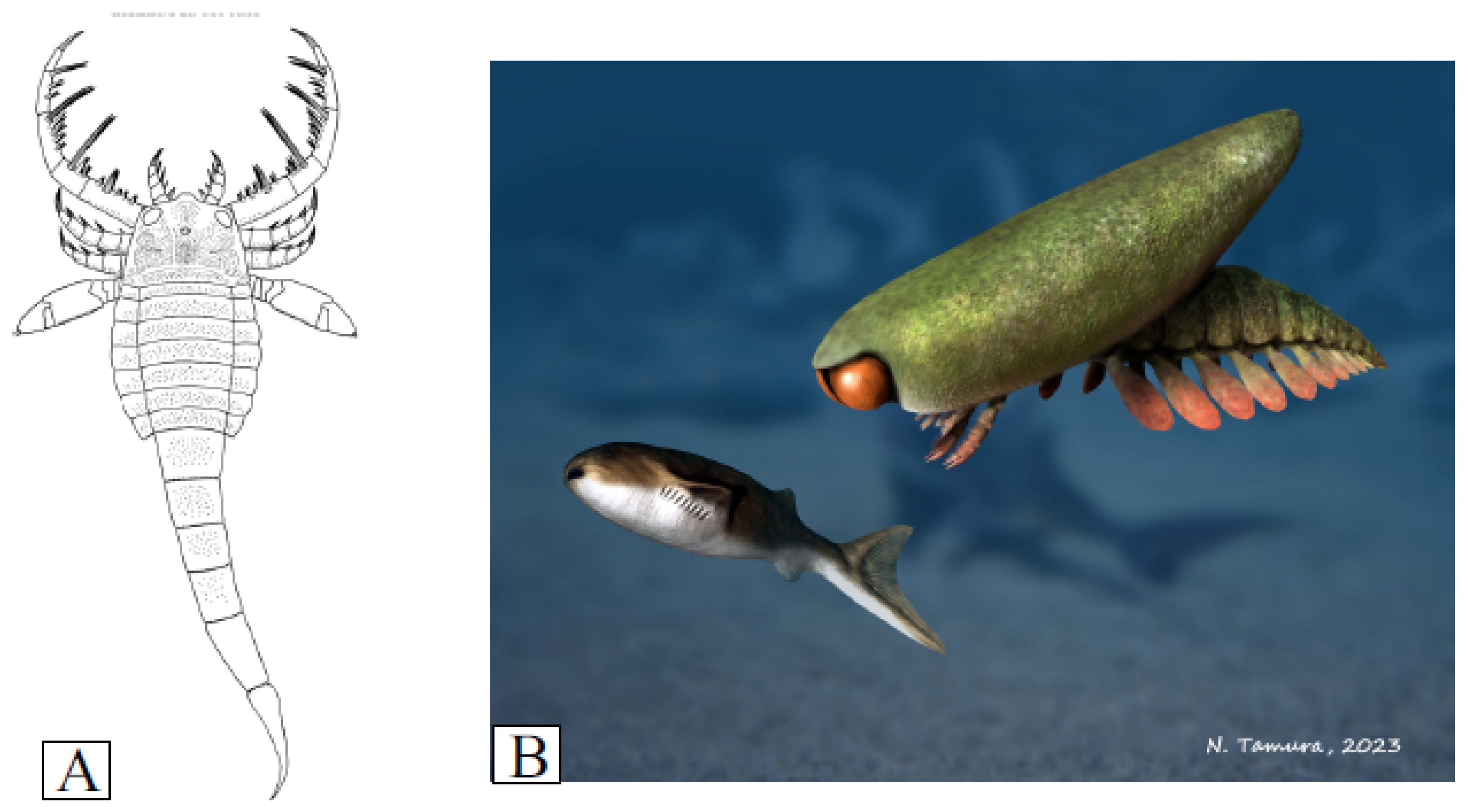

| Taxa | Feeding Strategy | Frequency |
|---|---|---|
| Arthropods | ||
| Ceratiocaris papilio | nektonic omnivore | very common |
| Slimonia acuminata | nektonic scavenger | rare |
| Erretopterus bilobus | nektonic carnivore | very rare |
| Ainiktozoon loganense | unknown | common |
| Beyrichias sp. (1 specimen) detritivore | very rare | |
| Chordata | ||
| Loganellia scotica | nektonic detritus/herbivore? | common |
| Jamoytius kerwoodi | nektonic detritus/herbivore? | rare |
| Loganellia grossi | nektonic detritus/herbivore? | very rare |
| Cephalopoda | ||
| ?Orthocone indeterminate | nektonic carnivore | very rare |
| Small (2 specimens) | ||
| Gastropoda | ||
| Platyschisma helicites | mobile herbivore, grazer | rare |
| (7 specimens) | ||
| Bivalvia | ||
| Pteritonella sp. | bysally attached suspension feeder | rare |
| Unknown | ||
| Dictyocaris slimoni | plant primary producer? | very common |
| Plant | ||
| Tatia catena | primary producer | very rare |
Disclaimer/Publisher’s Note: The statements, opinions and data contained in all publications are solely those of the individual author(s) and contributor(s) and not of MDPI and/or the editor(s). MDPI and/or the editor(s) disclaim responsibility for any injury to people or property resulting from any ideas, methods, instructions or products referred to in the content. |
© 2024 by the author. Licensee MDPI, Basel, Switzerland. This article is an open access article distributed under the terms and conditions of the Creative Commons Attribution (CC BY) license (https://creativecommons.org/licenses/by/4.0/).
Share and Cite
Brookfield, M.E. The Life and Death of Jamoytius kerwoodi White; A Silurian Jawless Nektonic Herbivore? Foss. Stud. 2024, 2, 77-91. https://doi.org/10.3390/fossils2020003
Brookfield ME. The Life and Death of Jamoytius kerwoodi White; A Silurian Jawless Nektonic Herbivore? Fossil Studies. 2024; 2(2):77-91. https://doi.org/10.3390/fossils2020003
Chicago/Turabian StyleBrookfield, Michael E. 2024. "The Life and Death of Jamoytius kerwoodi White; A Silurian Jawless Nektonic Herbivore?" Fossil Studies 2, no. 2: 77-91. https://doi.org/10.3390/fossils2020003
APA StyleBrookfield, M. E. (2024). The Life and Death of Jamoytius kerwoodi White; A Silurian Jawless Nektonic Herbivore? Fossil Studies, 2(2), 77-91. https://doi.org/10.3390/fossils2020003






